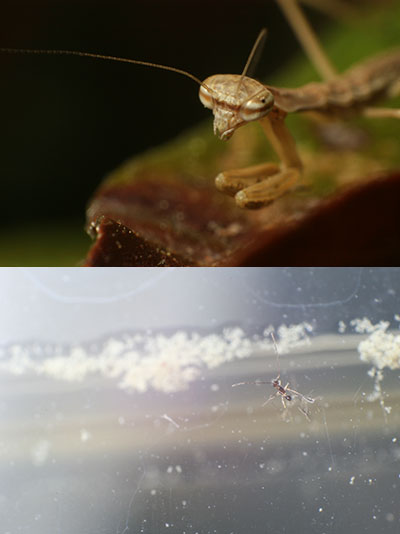
The singular appearance of this one herein may solely be my own fault – or it may not. But that’s why you come here, right? For the definitive answers?
This is a species of fairy wasp, of the Family Mymaridae, potentially of the genus Mymar, and it looks this vague and indistinct because it’s really tiny. I mean really. As in, the body length is in the range of half of a millimeter, so we’re at the limits of resolution for the lens I was using, which was the reversed 28-105. I was photographing other subjects in a macro aquarium when it landed on the glass in front of me and I could just make out a speck moving around, so I refocused onto it for this image. Only afterward, examining the image at full resolution on the computer, did I realize that I had found something really weird. Because yes, those are its wings, not even apparently sufficient for a fan, but given the minuscule mass of the insect, sufficient to propel it around.
 I only know the size of it this accurately, which is not terribly so, because in the same session, I photographed a newborn Chinese mantis (Tenodera sinensis), both seen here at full frame, and I was able to obtain an acceptable measurement of that with my calipers, very gingerly; the eyes are less than 2mm across, closer to 1. Those wings, of course, helped to pin down the Family at least; the Mymaridae are parasitic wasps, which means they lay their eggs into the larva of other arthropods or even, like this Family, into the eggs of those, hatching out into the developing young and eating them from the inside. Not as cute now, is it? Okay, maybe you never thought it was cute to begin with…
I only know the size of it this accurately, which is not terribly so, because in the same session, I photographed a newborn Chinese mantis (Tenodera sinensis), both seen here at full frame, and I was able to obtain an acceptable measurement of that with my calipers, very gingerly; the eyes are less than 2mm across, closer to 1. Those wings, of course, helped to pin down the Family at least; the Mymaridae are parasitic wasps, which means they lay their eggs into the larva of other arthropods or even, like this Family, into the eggs of those, hatching out into the developing young and eating them from the inside. Not as cute now, is it? Okay, maybe you never thought it was cute to begin with…
So, have these remained unseen since then because they’re pretty scarce in the area, or because I have never sat down and peered nearsightedly at every little moving speck that is within reach? That’s a good question, though I can say that the latter is true enough; I tend to forget about these until reminded again. Since I found this one at this time of year (realizing I could have posted it a day after its tenth anniversary, last week,) I should be looking again, though whether I could get any better images of it now remains to be seen (heh!) – the details of it are small enough that light refraction starts to play a significant role, and even under the microscope I may not achieve a lot better detail without image stacking. Which I need to be trying anyway. Excuse me while I go out and stare at surfaces a couple centimeters from my nose…



















































